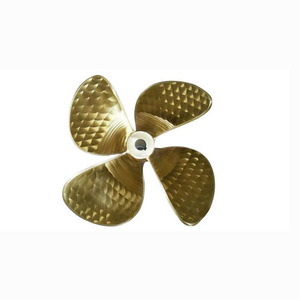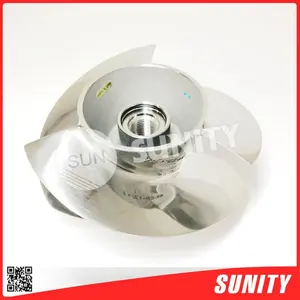Types of SOLAS Propellers
SOLAS propellers are engineered for various marine applications, offering different materials and designs to match specific boat requirements and performance goals. Here's a breakdown of the main types available:
Aluminum Propellers
Aluminum SOLAS propellers offer an excellent balance of affordability and flexibility. They're ideal for recreational boating and light towing operations.
Key Benefits: Can bend when hitting debris (reducing engine damage), easy to repair, cost-effective, improved fuel efficiency
Stainless Steel Propellers
Stainless steel SOLAS propellers deliver exceptional durability and corrosion resistance, perfect for high-performance vessels and challenging marine environments.
Key Benefits: Superior strength, excellent acceleration, higher top speeds, withstands high-power engines, longevity in harsh conditions
Composite Propellers
The newest innovation in the SOLAS lineup, composite propellers combine materials like aluminum and plastics to create advanced performance characteristics.
Key Benefits: Lighter weight, enhanced corrosion resistance, improved flexibility, combines advantages of multiple materials
Expert Tip: When selecting between aluminum and stainless steel propellers, consider your boating habits. Aluminum works well in shallow waters where obstacles might be present, while stainless steel offers better performance for open-water, high-speed applications.
Blade Configuration Options
| Blade Configuration | Ideal Applications | Performance Characteristics |
|---|---|---|
| 4-Blade Propellers | Towing, cargo transport, precision fishing | Strong, consistent thrust; better low-speed control; reduced slippage; improved stability |
| 5-Blade Propellers | Racing vessels, luxury yachts, high-performance boats | Minimized cavitation; improved fuel efficiency; smoother operation; higher top speeds |
| 3-Blade Propellers | General recreational use, balanced performance | Good all-around performance; balanced efficiency and power; most common configuration |
Specifications and Maintenance of SOLAS Propellers
Key Specifications
Understanding the technical specifications of SOLAS propellers is essential for selecting the right model for your vessel and ensuring optimal performance.
| Specification | Description | Impact on Performance |
|---|---|---|
| Diameter & Pitch | Diameter is the circle created by rotating blades; pitch is the theoretical forward distance traveled in one rotation | Affects thrust, speed, and engine RPM; matching to engine specifications is critical |
| Number of Blades | Ranges from 3-5 blades, each configuration offering different performance characteristics | More blades provide better thrust and stability but may reduce top speed |
| Material | Primary options include aluminum, stainless steel, and composite materials | Affects durability, repair options, performance, and price point |
| Engine Compatibility | Must match horsepower, RPM range, and engine type specifications | Improper matching can cause poor performance, excessive vibration, and engine damage |
| Propeller Type | Includes stern drive, outboard, and inboard propellers designed for specific systems | Each type is engineered for particular boat propulsion systems and applications |
Comprehensive Maintenance Guide
Proper maintenance extends propeller life, ensures optimal performance, and prevents costly repairs. Follow this essential maintenance schedule:
Regular Inspection & Cleaning
Frequency: After each use / Monthly
Thoroughly inspect for damage, debris, and marine growth. Clean with appropriate marine-grade cleaners to remove buildup that can affect performance.
Pro Tip: Look for hairline cracks that may not be immediately visible but can worsen over time
Damage Repair & Lubrication
Frequency: As needed / Quarterly
Address nicks, dents, or bent blades promptly. Regularly lubricate propeller shaft bearings with marine-grade grease to ensure smooth operation.
Warning: Even minor blade damage can cause vibration that damages other components
Seasonal Maintenance & Storage
Frequency: End of season / Extended non-use
Remove, thoroughly clean, and inspect the propeller before storage. Store in a dry, protected environment, and consider professional reconditioning for heavily used propellers.
Best Practice: Apply a thin coat of corrosion inhibitor during storage periods
Important: Never run the engine while the boat is out of water without using a flushing attachment. Running "dry" can cause serious damage to both the propeller and engine cooling systems.
How to Choose the Right SOLAS Propeller
Selecting the optimal SOLAS propeller involves careful consideration of your vessel specifications, operating conditions, and performance goals. This comprehensive guide will help you make an informed decision.
| Selection Factor | Considerations | Recommendations |
|---|---|---|
| Boat Type & Usage | Different boat types and activities require specific propeller characteristics | Fishing boats: Focus on thrust and control Ski boats: Prioritize acceleration and top speed Cruising vessels: Balance efficiency and comfort |
| Engine Specifications | Propeller must match engine's horsepower, torque ratings, and recommended RPM range | Consult your engine manual for optimal propeller specifications Stay within 200-300 RPM of manufacturer's recommended WOT (Wide Open Throttle) |
| Boat Size & Weight | Heavier boats need more thrust; hull design affects propeller performance | Larger/heavier boats: Lower pitch, more surface area Lighter boats: Higher pitch possible for better top speed |
| Operating Environment | Water conditions and salinity affect propeller material choice | Saltwater: Stainless steel or composite for corrosion resistance Rocky/shallow areas: Aluminum for damage resilience |
| Performance Goals | Balance between acceleration, top speed, efficiency, and handling | Higher pitch: Better top speed Lower pitch: Better acceleration More blades: Improved stability and thrust |
Expert Advice: When in doubt, it's often better to start with a slightly lower pitch than you think you need. You can always increase pitch to gain top speed, but an over-pitched propeller can cause engine lugging, overheating, and poor acceleration.
Testing Your Propeller Selection
The ideal propeller should allow your engine to reach its recommended WOT (Wide Open Throttle) RPM range. After installation, conduct these performance tests:
- Acceleration test: Time how quickly the boat reaches cruising speed from standstill
- Top speed test: Measure maximum speed at full throttle in safe conditions
- Fuel efficiency check: Monitor fuel consumption at cruising speed
- RPM verification: Ensure engine reaches manufacturer's recommended RPM range at full throttle
If your engine can't reach its recommended RPM range, you may need a propeller with less pitch. If it exceeds the range too easily, consider increasing pitch.
DIY SOLAS Propeller Replacement Guide
Replacing your boat's propeller is a manageable DIY project that can save on maintenance costs. Follow this step-by-step guide for a safe and successful installation of your new SOLAS propeller.
Safety Warning: Always disconnect the battery or remove the ignition key before working on the propeller to prevent accidental engine starts. Wear protective gloves to avoid cuts from sharp propeller edges.
Required Tools
- Socket set or propeller wrench (sized for your propeller nut)
- Rubber mallet
- Marine-grade grease
- Torque wrench
- Needle-nose pliers (for cotter pins if applicable)
- Anti-seize compound
- Protective gloves
1Safety Preparations
Ensure the boat is in a stable position, either on a trailer or securely docked. Turn off the engine and remove the key from the ignition. If possible, disconnect the battery to eliminate any risk of accidental engine start.
2Remove Propeller Guard
If your boat has a propeller guard or other protective covers, remove them first to gain clear access to the propeller assembly. Keep track of all fasteners for reassembly.
3Loosen and Remove Hardware
Use the appropriate wrench to loosen the propeller nut. Remove the nut, washer, spacer, and any other hardware, noting the exact order for reinstallation. Some propellers use cotter pins that must be removed first.
4Remove Old Propeller
Grasp the propeller firmly and pull it straight off the shaft. If it's stuck, gently tap with a rubber mallet to loosen. Never use metal hammers that could damage the components.
5Inspect and Clean the Shaft
Examine the propeller shaft for damage or debris. Clean thoroughly and check for fishing line wrapped around the shaft or behind the seal which can cause damage if not removed.
6Prepare New Propeller
Apply a thin layer of marine-grade grease to the propeller shaft and splines. This lubricates the installation and makes future removal easier while helping prevent corrosion.
7Install New SOLAS Propeller
Slide the new propeller onto the shaft, aligning it properly with the splines. Ensure it seats fully and rotates freely once mounted. Reapply anti-seize compound to threads.
8Reinstall Hardware
Replace all washers, spacers, and nuts in the exact order they were removed. Tighten the propeller nut to the manufacturer's specified torque using a torque wrench for precision.
9Secure and Test
If your propeller uses a cotter pin for securing the nut, install a new one (never reuse old cotter pins). Reinstall the propeller guard if applicable. Manually rotate the propeller to ensure free movement.
10Final Verification
Before water testing, double-check all connections. Once on the water, start with low-speed operation to verify proper installation before progressing to higher speeds and full performance testing.
Maintenance Tip: After the first few hours of operation with your new propeller, re-check the tightness of the propeller nut. Initial use can sometimes cause slight settling of components that may require minor adjustment.
Frequently Asked Questions
A SOLAS propeller is a high-quality marine propeller manufactured by Solas Science & Engineering Co., Ltd. These propellers are engineered with precision and advanced materials to provide optimal performance for various types of boats and engines. SOLAS propellers are known for their excellent build quality, performance characteristics, and attention to detail in design.
SOLAS propellers are designed in Taiwan and manufactured in production facilities located in China. Despite having manufacturing operations in China, SOLAS maintains strict quality control standards to ensure their propellers meet international performance and durability benchmarks. The company combines Taiwanese engineering expertise with cost-effective manufacturing capabilities.
SOLAS propellers are made by Solas Science & Engineering Co., Ltd., a Taiwanese company specializing in marine propulsion technology. Founded in 1985, the company has established itself as a global leader in propeller manufacturing, with a reputation for innovation and quality. They produce propellers for various marine applications, from small recreational boats to larger commercial vessels.
Yes, SOLAS is widely recognized as a high-quality propeller brand. The company has built a strong reputation for manufacturing reliable, durable, and performance-oriented propellers that meet or exceed international standards. Many boaters and marine professionals consider SOLAS propellers to offer excellent value, combining reasonable pricing with superior engineering and consistent performance across their product range.
SOLAS manufactures propellers in both stainless steel and aluminum, with each material offering distinct advantages. Their stainless steel propellers provide exceptional durability, corrosion resistance, and performance benefits like improved acceleration and higher top speeds. However, SOLAS also produces high-quality aluminum propellers that offer advantages such as affordability, easier repairs after impact damage, and good all-around performance for recreational boating applications.
The lifespan of a SOLAS propeller depends on several factors including material, usage conditions, and maintenance. With proper care, stainless steel SOLAS propellers can last 10+ years, while aluminum models typically last 3-5 years under normal recreational use. Regular inspection, cleaning, and proper storage significantly extend propeller life. Operating in sandy, shallow waters or high-debris environments will shorten the service life of any propeller.













































































































































































































































 浙公网安备 33010002000092号
浙公网安备 33010002000092号 浙B2-20120091-4
浙B2-20120091-4